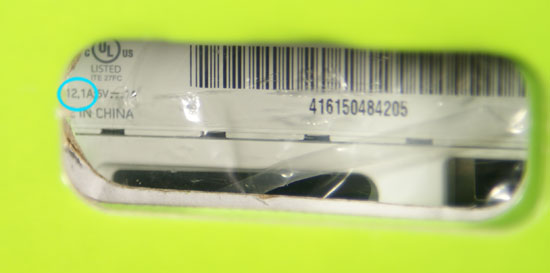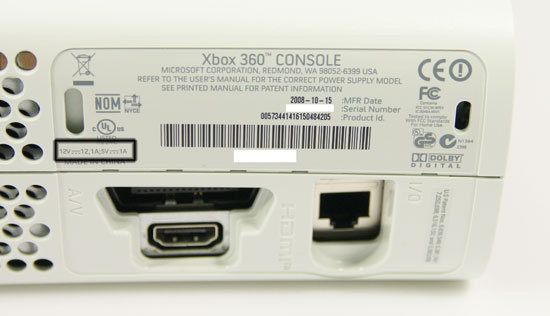Jasper Is Here: A Look at the New Xbox 360
by Anand Lal Shimpi on December 10, 2008 12:00 AM EST- Posted in
- Smartphones
- Mobile
Identifying a Jasper
Unlike the Falcon transition, the move to Jasper isn't very clean cut. You can't rely on a lot number or manufacturing date to tell you whether or not you've got a Jasper, there are some hints and only one sure-fire way to determine if you're holding a box with a Jasper inside without actually opening the packaging.
The hints are pretty basic: the Xbox 360 Arcade bundles appear to be the best chance at getting a Jasper right now, although there have been reports of some Xbox 360 Pro systems featuring Jasper. As of now there haven't been any confirmed Elites that have the Jasper boards in them. Remember that Jasper is not only a potential fix for the RRoD, but is also a cost reduction for Microsoft - the GPU die is smaller and the power supply is less powerful, which means lower overall costs - something that makes the most sense in the most price constrained of the three Xbox 360s available today: the $199 Arcade.
| Xbox 360 Arcade | Things to Look For | Likelihood that You've Got a Jasper |
| Lot # | 0842X or newer | Maybe |
| Xbox 360 Arcade Sticker Markings | XGX-00019 | Probably a Guarantee |
| Xbox 360 Arcade Sticker Markings | Value Bundle 2008 E | Probably a Guarantee |
| Current Rating on 12V Rail | 12.1A | Guaranteed |
The first thing you'll want to do is look at the sticker on the outside of the box, this will have the lot number, team and some other potentially useful information. The lot numbers you're looking for are 0842X or newer, although unlike Falcon-hunting, the lot number won't guarantee you a Jasper. The lot number refers to the year and week that the console was built, 08 being the year, 42 being the 42nd week of the year. The X is there for, well, good luck I guess. The team isn't as important as it was in the Falcon days either, Xbox 360 Arcade bundles marked lot 0842X from team CSON and FDOU have been both Jasper or Falcons.

If you can't rely on the lot number and manufacturing team, then what can you? The sticker on the side of the box holds the first clues, while you can find the lot number here that's just a quick way of determining the likelihood of you having found a Jasper (e.g. if your lot number is really old, like 0830 then it's not a Jasper). There are two lines that right now appear to be good indications that you may have found a Jasper, I've highlighted them in the picture below:
If you see this XGX-00019 line below the top barcode, chances are that you've got a Jasper. And if you see this Xbox 360 Arcade System Value Bundle 2008 E line (exactly like that, note that this only applies to Arcade units) then you most likely have a Jasper as well. If you want full confirmation though you'll need to look at the current rating on the 12V rail which, believe it or not, you can do without ever opening the box.
Microsoft cut out a little window in the Xbox 360 packaging to allow the barcode/serial number to be scanned. Looking through this window the information you want is most likely obstructed by the cardboard cutout and it's to the left of the opening. The least destructive way to get access to this information is to push down on the Xbox 360 itself through the window on the right side, which will hopefully reveal the information you're looking for. A quicker, easier and potentially get-you-kicked-out-of-the-store way is to push the cardboard itself to the left a bit, possibly even tearing it slightly, to reveal the text you're interested in. The line you're looking for is this:



12.1A on the 12V rail nets you a Jasper
The important text is the current rating on the 12V line, which is immediately to the left of the current rating on the 5V rail. The three options here are 16,5A, 14,2A and 12,1A. All that really matters is the last digit, if you see a 5 then you've got a Zephyr, if you see a 2 you've got a Falcon (most likely) or if you see a 1 you've got a Jasper (take it and run).
| 12V Current Rating | Xbox 360 Revision |
| 16,5A | Zephyr |
| 14,2A | Falcon |
| 12,1A | Jasper |
Now some Jaspers have been mislabeled as 14,2A, but no Zephyr or Falcon has been mislabeled as 12,1A. The explanation is simple, this rating indicates what sort of power supply you'll need to use with the machine. Zephyr and Falcon boxes can't run with only 12.1A on the 12V rail, you'd end up with a box that either crashed a lot, rebooted or had other undesirable behavior (assuming it would even start, assuming you could even find a power supply that you could plug into it). There's only one Xbox 360 power supply that can deliver a max of 12.1A on the 12V rail, that is the 150W power supply that is keyed to only work on Jaspers. Find a machine with 12,1A written on the back of it and you've got yourself a Jasper.
Sneaky Microsoft: Still Shipping Zephyrs
In my Jasper hunting I came across a strange beast, I found an Xbox 360 Pro with lot number 0843X. I figured it was new enough that it could be a Jasper, but looking at the 12V current rating I found that it was a 16.5A unit. I thought perhaps it was mislabeled and I'd heard about some newer systems having a 16.5A 12V rating, so I thought I'd buy it and take a closer look.
Once I got it home I confirmed: the machine was a Zephyr, that's the original Xbox 360 hardware with HDMI support, meaning a 90nm CPU, 90nm GPU and 90nm eDRAM - the very configuration most likely to Red Ring. I'm guessing it's a reworked Xbox 360 that never made it out of the factory in the first place due to an instant failure; something Microsoft fixed and sent out at a much later date.
Even if you don't care about getting a Jasper, it may be worth looking into what it is you are getting to make sure that you're not stuck with a box that's more likely to fail.










84 Comments
View All Comments
kilkennycat - Wednesday, December 10, 2008 - link
Yep, and for the latest classic example, consider the PC port of GTA4. This port hold the all-time (so far) rotten-banana-prize for the worst console to PC port of a major video-game. Besides the DRM and gross game-play/graphics bugs, the game REQUIRES at least 3 CPU-cores for optimum performance. Code obviously ported over from the 3-core Xbox360 version, with zero optimization for a fewer number of far more capable PC CPU cores. The cartoon-type graphics puts little stress on the GPU. Hopefully, Anandtech in one of the occasional PC game-related articles will lacerate Rockstar and Take Two for this lazily-awful port to the PC.seriouscat - Wednesday, December 10, 2008 - link
Comon AT! Wheres the temperature benchmarks? This was the single most interesting test I was looking foward to after all these months and what do I read? Nothing!Pirks - Wednesday, December 10, 2008 - link
Otherwise he wouldn't write "I'm actually a bit surprised that we haven't seen more focus on delivering incredible visuals on PC games given the existing performance gap" because the answer to that has been printed in media many times, and here it is posted on DailyTech this morning: http://www.dailytech.com/article.aspx?newsid=13648">http://www.dailytech.com/article.aspx?newsid=13648See Anand, it's really easy to make you stop feeling surprised. You won't ever now, will ya? Just remember this P-word, always remember it.
Gunbuster - Wednesday, December 10, 2008 - link
"Most lead-free replacements for conventional Sn60/Pb40 and Sn63/Pb37 solder have melting points from 5–20 °C higher"You need to back up your facts in this one boys.
Staples - Wednesday, December 10, 2008 - link
I have yet to see someone hook up a Jasper to a current meter to test out how much power the darn thing draws.I hope this does cure the RROD because my launch system (Xenon) and the Falcon I bought a year ago both have gone bad. The Falcon used much less power but if the GPU was the real cause of the RROD like many speculate, then hopefully this die shrink takes care of it.
And for all of those who do not know which version you have, do what I do. I have never once looked into the console with a flashlight. I have a kill a watt meter and by comparing anand's numbers to that of your own will narrow down the generation of Xbox you have.
ss284 - Wednesday, December 10, 2008 - link
Power(W) = current(A) * voltage(V).I'm assuming you can do the math. The killawatt is in essence a volt/current meter.
sprockkets - Wednesday, December 10, 2008 - link
Close. Watts is energy. Watts over time is power, or kWh.ahmshaegar - Wednesday, December 10, 2008 - link
Wow. Can't believe I just saw someone post that.The watt is definitely a unit of power. Power is the rate at which you use energy. 1 W = 1 J/s. So the kWh is actually a unit of energy, since you multiply the watt with the hour (a unit of time), which is very odd* if you think about it (1 W = 1 J/s, so 1 kWh is 1000 Wh, or 1000 (J/s)h.
Because 1 hour contains 3600 seconds, 1 kWh is 1000 joules per second multiplied by 1 hour multiplied by 3600 seconds per hour (this last term converts the 1 hour to seconds, so I can cancel out the seconds.)
You then get 1 kWh = 3600000 J, proving that the kWh is indeed a unit of energy.
*It's one of those odd units if you just think about it, but very useful for the utilities.
adhoc - Wednesday, December 10, 2008 - link
I don't understand the comment about lead-free solder melting at high temperatures...Lead-free solder actually has a HIGHER melting point than leaded solder. Instead of worrying about solder melting at "high temperatures" from chip heat dissipation, I'd be more worried about PCB and component reliabilities due to the initial soldering process. PCB laminates that aren't suited for lead-free/RoHS elevated temperatures can warp and/or delaminate, creating immediate or possibly latent failures.
Aside from the PCB materials, components need to be characterized for the higher temperatures during the reflow/wave processes. Ceramic capacitors come to mind as a specific issue; the ceramic can crack under high temperatures (especially temperature gradients during hand-soldering), which can eventually create an open circuit, or worse even a short between power planes.
In the end, I'm just dubious of the explanation of lead-free solder as the failure mode. On the ohter hand, it may very well be related to the required higher temperatures during assembly (and thus bad PCBs and/or component failures).
The0ne - Wednesday, December 10, 2008 - link
Some designers don't account for the higher temperatures when they design PCBs. Actually there's quite alot of them around. That and mixing leaded and lead free parts where SMT has a much harder time processing them. In such case, they end up separating the process to lead, lead-free and sometimes even hand solder because of the particular design. Then you have designs that doesn't take into consideration of the distances between components or more specifically between vias. With very fine pitches this can become a nightmare for SMT.